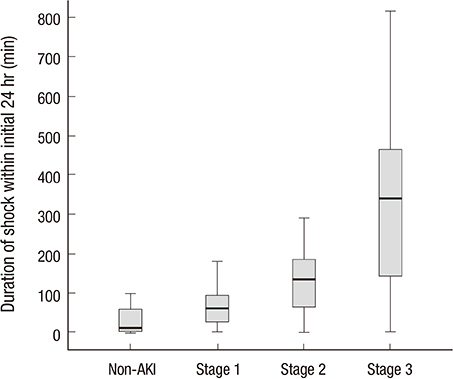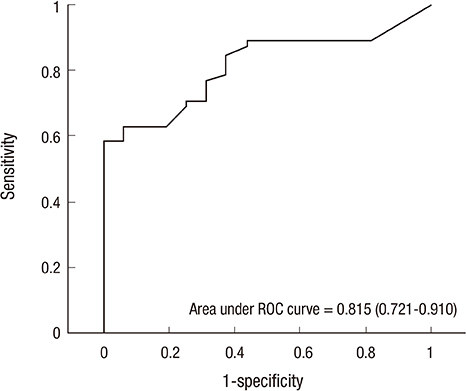J Korean Med Sci.
2015 Jun;30(6):802-807. 10.3346/jkms.2015.30.6.802.
Shock Duration after Resuscitation Is Associated with Occurrence of Post-Cardiac Arrest Acute Kidney Injury
- Affiliations
-
- 1Department of Emergency Medicine, Yonsei University Wonju College of Medicine, Wonju, Korea. shwang@yonsei.ac.kr
- 2Department of Nephrology, Yonsei University Wonju College of Medicine, Wonju, Korea.
- 3Institute of Lifestyle Medicine, Yonsei University Wonju College of Medicine, Wonju, Korea.
- KMID: 2160611
- DOI: http://doi.org/10.3346/jkms.2015.30.6.802
Abstract
- This retrospective observational study investigated the clinical course and predisposing factors of acute kidney injury (AKI) developed after cardiac arrest and resuscitation. Eighty-two patients aged over 18 yr who survived more than 24 hr after cardiac arrest were divided into AKI and non-AKI groups according to the diagnostic criteria of the Kidney Disease/Improving Global Outcomes (KDIGO) Clinical Practice Guidelines for AKI. Among 82 patients resuscitated from cardiac arrest, AKI was developed in 66 (80.5%) patients (AKI group) leaving 16 (19.5%) patients in the non-AKI group. Nineteen (28.8%) patients of the AKI group had stage 3 AKI and 7 (10.6%) patients received renal replacement therapy during admission. The duration of shock developed within 24 hr after resuscitation was shorter in the non-AKI group than in the AKI group (OR 1.02, 95% CI 1.01-1.04, P < 0.05). On Multiple logistic regression analysis, the only predisposing factor of post-cardiac arrest AKI was the duration of shock. In conclusion, occurrence and severity of post-cardiac arrest AKI is associated with the duration of shock after resuscitation. Renal replacement therapy is required for patients with severe degree (stage 3) post-cardiac arrest AKI.
Keyword
MeSH Terms
-
Acute Kidney Injury/*mortality/*therapy
Aged
Female
Heart Arrest/*mortality/*therapy
Humans
Incidence
Male
Middle Aged
Renal Replacement Therapy/mortality
Republic of Korea/epidemiology
Resuscitation/*mortality
Retrospective Studies
Risk Factors
Severity of Illness Index
Shock/*mortality
Survival Rate
Treatment Outcome
Figure
Reference
-
1. Neumar RW, Nolan JP, Adrie C, Aibiki M, Berg RA, Böttiger BW, Callaway C, Clark RS, Geocadin RG, Jauch EC, et al. Post-cardiac arrest syndrome: epidemiology, pathophysiology, treatment, and prognostication. A consensus statement from the International Liaison Committee on Resuscitation (American Heart Association, Australian and New Zealand Council on Resuscitation, European Resuscitation Council, Heart and Stroke Foundation of Canada, InterAmerican Heart Foundation, Resuscitation Council of Asia, and the Resuscitation Council of Southern Africa); the American Heart Association Emergency Cardiovascular Care Committee; the Council on Cardiovascular Surgery and Anesthesia; the Council on Cardiopulmonary, Perioperative, and Critical Care; the Council on Clinical Cardiology; and the Stroke Council. Circulation. 2008; 118:2452–2483.2. Adrie C, Adib-Conquy M, Laurent I, Monchi M, Vinsonneau C, Fitting C, Fraisse F, Dinh-Xuan AT, Carli P, Spaulding C, et al. Successful cardiopulmonary resuscitation after cardiac arrest as a "sepsis-like" syndrome. Circulation. 2002; 106:562–568.3. Adrie C, Laurent I, Monchi M, Cariou A, Dhainaou JF, Spaulding C. Postresuscitation disease after cardiac arrest: a sepsis-like syndrome? Curr Opin Crit Care. 2004; 10:208–212.4. Samborska-Sablik A, Sablik Z, Gaszynski W. The role of the immuno-inflammatory response in patients after cardiac arrest. Arch Med Sci. 2011; 7:619–626.5. Hasper D, von Haehling S, Storm C, Jörres A, Schefold JC. Changes in serum creatinine in the first 24 hours after cardiac arrest indicate prognosis: an observational cohort study. Crit Care. 2009; 13:R168.6. Bonventre JV, Yang L. Cellular pathophysiology of ischemic acute kidney injury. J Clin Invest. 2011; 121:4210–4221.7. Sharfuddin AA, Molitoris BA. Pathophysiology of ischemic acute kidney injury. Nat Rev Nephrol. 2011; 7:189–200.8. Mattana J, Singhal PC. Prevalence and determinants of acute renal failure following cardiopulmonary resuscitation. Arch Intern Med. 1993; 153:235–239.9. Domanovits H, Müllner M, Sterz F, Schillinger M, Klösch C, Paulis M, Hirschl MM, Laggner AN. Impairment of renal function in patients resuscitated from cardiac arrest: frequency, determinants and impact on outcome. Wien Klin Wochenschr. 2000; 112:157–161.10. Kellum JA, Lameire N. KDIGO AKI Guideline Work Group. Diagnosis, evaluation, and management of acute kidney injury: a KDIGO summary (Part 1). Crit Care. 2013; 17:204.11. Jacobs I, Nadkarni V, Bahr J, Berg RA, Billi JE, Bossaert L, Cassan P, Coovadia A, D'Este K, Finn J, et al. International Liaison Committee on Resuscitation. American Heart Association. European Resuscitation Council. Australian Resuscitation Council. New Zealand Resuscitation Council. Heart and Stroke Foundation of Canada. InterAmerican Heart Foundation. Resuscitation Councils of Southern Africa. ILCOR Task Force on Cardiac Arrest and Cardiopulmonary Resuscitation Outcomes. Cardiac arrest and cardiopulmonary resuscitation outcome reports: update and simplification of the Utstein templates for resuscitation registries: a statement for healthcare professionals from a task force of the International Liaison Committee on Resuscitation (American Heart Association, European Resuscitation Council, Australian Resuscitation Council, New Zealand Resuscitation Council, Heart and Stroke Foundation of Canada, InterAmerican Heart Foundation, Resuscitation Councils of Southern Africa). Circulation. 2004; 110:3385–3397.12. Yanta J, Guyette FX, Doshi AA, Callaway CW, Rittenberger JC. Post Cardiac Arrest Service. Renal dysfunction is common following resuscitation from out-of-hospital cardiac arrest. Resuscitation. 2013; 84:1371–1374.13. Domanovits H, Schillinger M, Müllner M, Thoennissen J, Sterz F, Zeiner A, Druml W. Acute renal failure after successful cardiopulmonary resuscitation. Intensive Care Med. 2001; 27:1194–1199.14. Bellomo R, Ronco C, Kellum JA, Mehta RL, Palevsky P. Acute Dialysis Quality Initiative workgroup. Acute renal failure - definition, outcome measures, animal models, fluid therapy and information technology needs: the Second International Consensus Conference of the Acute Dialysis Quality Initiative (ADQI) Group. Crit Care. 2004; 8:R204–R212.15. Mehta RL, Kellum JA, Shah SV, Molitoris BA, Ronco C, Warnock DG, Levin A. Acute Kidney Injury Network. Acute Kidney Injury Network: report of an initiative to improve outcomes in acute kidney injury. Crit Care. 2007; 11:R31.16. Chua HR, Glassford N, Bellomo R. Acute kidney injury after cardiac arrest. Resuscitation. 2012; 83:721–727.17. Sutton TA, Fisher CJ, Molitoris BA. Microvascular endothelial injury and dysfunction during ischemic acute renal failure. Kidney Int. 2002; 62:1539–1549.18. Kern KB, Hilwig RW, Rhee KH, Berg RA. Myocardial dysfunction after resuscitation from cardiac arrest: an example of global myocardial stunning. J Am Coll Cardiol. 1996; 28:232–240.19. Laurent I, Monchi M, Chiche JD, Joly LM, Spaulding C, Bourgeois B, Cariou A, Rozenberg A, Carli P, Weber S, et al. Reversible myocardial dysfunction in survivors of out-of-hospital cardiac arrest. J Am Coll Cardiol. 2002; 40:2110–2116.20. Peberdy MA, Callaway CW, Neumar RW, Geocadin RG, Zimmerman JL, Donnino M, Gabrielli A, Silvers SM, Zaritsky AL, Merchant R, et al. American Heart Association. Part 9: post-cardiac arrest care: 2010 American Heart Association Guidelines for Cardiopulmonary Resuscitation and Emergency Cardiovascular Care. Circulation. 2010; 122:S768–S786.
- Full Text Links
- Actions
-
Cited
- CITED
-
- Close
- Share
- Similar articles
-
- Management of Brain Injury after Post-cardiac Arrest Syndrome
- Management of post-cardiac arrest syndrome
- Acute Cardiac Arrest Occurred During Removal of Foreign Body in the Esophagus
- Repeating Cardiac Arrest and One Hour of Cardiopulmonary Resuscitation due to Severe Hyperkalemia after Reperfusion during a Liver Transplantation: A case report
- Survival after Cardiac Arrest due to Acute Methamphetamine Poisoning: A Case Report




